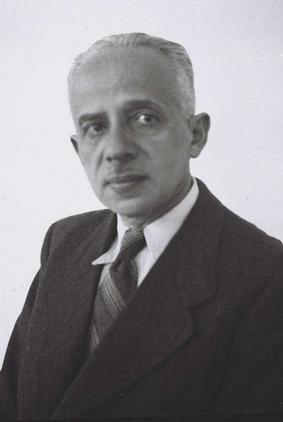Yaakov Cahan
(1881 – 1960)
 |
Yaakov Cahan was a Hebrew poet. Cahan was born in Slutsk, Russia, and spent his childhood and youth in Poland, in the town of Zgierz, near Lodz. Cahan became a prolific writer and with his first poem, published at the age of 18 in Sefer ha-Shanah, edited by N. *Sokolow (1900), he began his long career. At the same time, he was active in Zionist and Hebrew cultural circles. In 1907 he was secretary of the Ivriyyah organization and from 1910 until the outbreak of World War I he headed the Hebrew Language Culture organization in Berlin, whose main objective was to spread the knowledge of Hebrew. His yearning for the revival of Hebrew culture and for the "New Hebrew" (a term coined by Cahan) found expression in a number of literary and art miscellanies which he edited: Ha-Ivri he-Ḥadash (1912), Ha-Ogen (1917), and Seneh (1929). In 1918 he joined the Stybel Publishing House in Moscow and later, together with F. *Lachower, coedited 21 issues (4–24) of Ha-Tekufah in Warsaw, and two issues (28 and 29) on his own. Together with Lachower he also coedited the Keneset anthologies (from 1936 onward). Cahan was lecturer in Hebrew literature at the Warsaw Institute for Jewish Studies from 1927 to 1933, and immigrated in 1934 to Ereẓ Israel, where he lived in Tel Aviv.
The Polish Jewish life of his youth, marked by emotionalism, optimism, kindliness, and idealization, deeply affected the young Cahan. His response to the external world was one of emotion rather than reason and the underlying themes of his poetry – beauty for its own sake and the search for the good – penetrate all levels of his writings. Cahan, however, did
Cahan's hatred of the Diaspora, identifying it with the ugly, is the obverse of his love for the "New" Judaism welded to beauty. He saw the qualities that the galut ("exile") generated in the rootless Jew as an inherent ugliness, and he, therefore, negated the traditions sacred to the people, stating: "My heart has come to hate my brothers and to despise even that which is holiest to them."
Cahan was unaware of the conflicting forces at play in 20th-century man. He was rarely beset by doubts or skepticism, and, though lonely, he was a free spirit. His longing for the "New Hebrew" aroused in him a nostalgia for the distant, heroic Jewish past, which is a main theme of his poetry. His writings, however, are also inspired by those sparks of beauty that he felt had illuminated the darkness of the galut, and in this sense his poems and ballads draw life from the rich heritage of Jewish folklore.
His poetic sensitivity and curiosity encompass a wide range of subject matter and find expression in many different forms. Among the latter are the lyrical and descriptive poem (a cycle of poems called "Helveẓyah" in which he sings of the beauty of Switzerland); reflective and imaginative poetry ("Ariel"); lyrical epics ("Of ha-Ḥol"); dramatic poems ("Ha-Nefilim" and "Be-Luz"); and ballads based on Jewish folklore ("Tanḥum" and "Be-Emẓa ha-Rikkud" from the two series Min ha-Am). The subjects and themes of his writings include his visions of historical figures found in such poetic dramas as: "Yiftaḥ," "Hoshe'a," "Ezra u-Neḥemyah," "Yannai u-Shelomit," "Aḥer" (Elisha b. Avuya), and Me'ir u-Veruriyyah; messianic aspirations (the play "King David"); legends, allegories, and prophecies ("Aggadot Elohim," "Mishlei Kedumim" (1943), "Ḥamesh Megillot" (1941)). Cahan also wrote realistic prose, short stories, and plays. His translations of Goethe's Faust Part One, Iphigenie auf Tauris, and Torquato Tasso are masterpieces.
A rich heritage of Jewish folklore underlies Cahan's poems and ballads, which generically are halfway between the lyric and the epic. His dramatic poetry ("Aggadot Elohim," "Of ha-Ḥol," "Tanḥum," and some of the ballads in Rom u-Tehom) is also marked by epical grandeur. Cahan, however was not basically an epic poet, but rather a teller of legends; his style follows the Hebrew aggadah ("legend") in which epic and lyric elements are fused, and it is this fusion which is Cahan's hallmark. His verse dramas, "Ha-Nefilim," "Be-Luz," and "Le-yad ha-Piramidot," which are among Cahan's finest works, belong to this type of poetry.
Cahan's poetry revolves around two axes – messianism and the fusion of three major principles: beauty, holiness, and happiness. The messianic motif runs through most of his lyrical epics, verse dramas, and dramatized legends. It goes hand in hand with his identification of the Judaic-prophetic sanctity of life and the yearning for enlightened beauty and universal humanism, or with the identification of morality and the quest for happiness.
Cahan's writings were published in various editions. The main ones are the 12-volume jubilee edition (1950–56) and the two-volume edition (1964).
BIBLIOGRAPHY
F. Lachower, Shirah u-Maḥashavah (1953), 53–56; J. Klausner, Meshorerei Dorenu (1956), 176–200; Y. Koplewitz (Keshet), Be-Dor Oleh (1950), 57–91; A. Kariv, Iyyunim (1950), 133–5, 252–6; Kressel, Leksikon, 2 (1967), 118–20; S. Halkin, Modern Hebrew Literature (1950), index S.V. Cohen; R. Wallenrod, Literature of Modern Israel (1956), index S.V. Kahan; Waxman, Literature, 4 (1960), 298–306. ADD. BIBLIOGRAPHY: Y. David, Matityahu Shoham "Zor vi-Yerushalayim," Ya'akov Kahan, "Bluz" (1965); Y. Seh-Lavan, Ya'akov Kahan (1978), bibl.
Source: Encyclopaedia Judaica. © 2007 The Gale Group. All Rights Reserved.
Photo: Public Domain.


